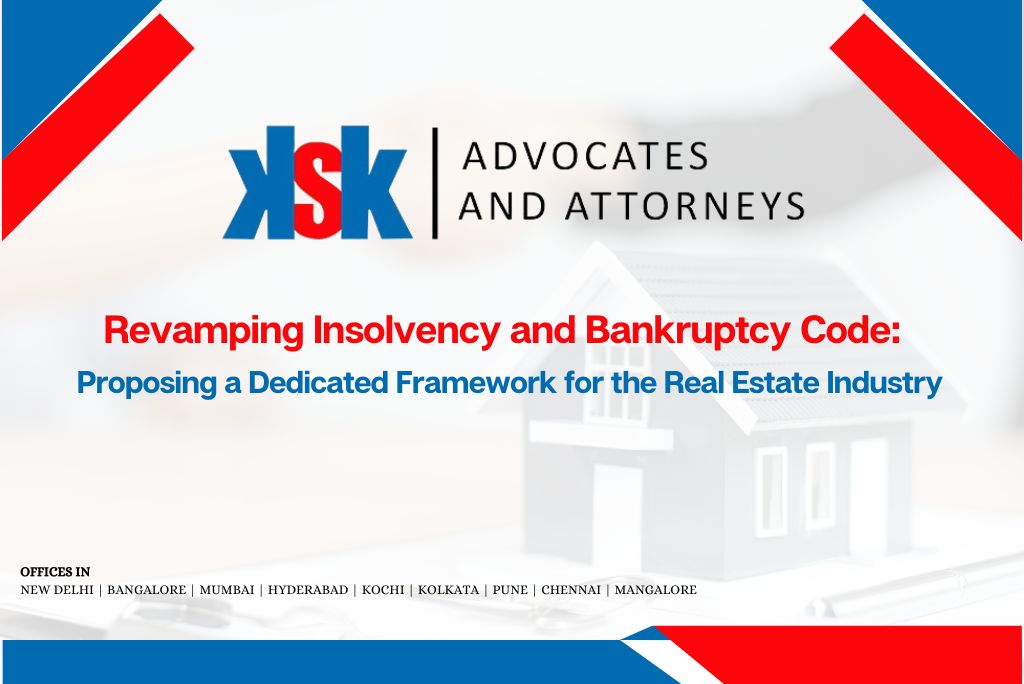Revamping Insolvency and Bankruptcy Code: Proposing a Dedicated Framework for the Real Estate Industry

The Insolvency and Bankruptcy Code (IBC) has played a crucial role in resolving insolvency cases across various sectors in India. However, the real estate sector presents unique challenges that necessitate the creation of a separate mechanism for insolvency resolution. This blog explores the need for a dedicated framework for the real estate industry within the IBC, addressing the sector’s vulnerabilities, information asymmetry, and proposing recommendations for a more effective resolution process.
Table of Contents
The Unique Challenges of the Real Estate Sector
- Vulnerability of the Real Estate Sector: Despite being a significant contributor to India’s GDP[1], the real estate sector faces challenges such as project approval delays, liquidity issues, and the cyclical nature of the industry. Additionally, the sector involves substantial investments from multiple stakeholders, including homebuyers, lenders, and contractors, making it particularly vulnerable to insolvency and bankruptcy.
- Homebuyers as Creditors: Unlike other sectors, the real estate sector has a substantial proportion of homebuyers as creditors. These individuals invest their life savings in housing projects, and in the event of insolvency or project delays, they suffer significant financial loss and emotional distress. Protecting the interests of homebuyers requires a specialized approach within the insolvency resolution process.
- Complexities of Real Estate Projects: Real estate assets are often spread across multiple states and involve various projects with different stages of completion and commercial requirements. This complexity demands a tailored mechanism to address the unique challenges arising from insolvency resolution in the real estate sector.
Observations by the National Company Law Appellate Tribunal (NCLAT)
The NCLAT has recognized the need for a special mechanism for the real estate industry in the context of Corporate Insolvency Resolution Process (CIRP). In the case of Flat Buyers Association Winter Hills v. Umang Realtech Pvt. Ltd.[2], it acknowledged that most financial creditors in real estate projects lack the necessary business acumen to evaluate the viability of a corporate debtor. This observation led to the development of the “reverse insolvency/project-wise insolvency” approach, allowing insolvency proceedings to be filed on a project-by-project basis. However, legislative reforms are essential to establish a specific procedure for the insolvency of real estate projects.
Addressing Information Asymmetry and Procedural Innovations
- Information Asymmetry: Homebuyers often face challenges in submitting their claims within the stipulated timeframe due to a lack of awareness and information regarding the Code’s operations. Amendments should require the Insolvency Resolution Professional/Resolution Professional (IRP/RP) to proactively contact homebuyers and inform them about the commencement of CIRP.
- Widening Public Announcements: To ensure greater dissemination of information, public announcements regarding the initiation of CIRP should extend beyond newspapers to include news channels and other accessible means.
Specialized NCLT Benches and Homebuyers as Financial Creditors
- Specialized NCLT Benches: Establishing specialized National Company Law Tribunal (NCLT) benches dedicated to real estate insolvencies would expedite the resolution process and ensure more efficient outcomes.
- Homebuyers as Financial Creditors: Given the significant investment made by homebuyers in residential units, they should be treated as financial creditors. This change would enhance their role in the insolvency resolution process and provide them with greater protection.
Further, in the recent case of Puneet Kaur v. KV Developers (P) Ltd.[3], the National Company Law Appellate Tribunal (NCLAT) acknowledged the long-standing legal principle that creditors not allowed to file a claim after the resolution plan has been approved by the Committee of Creditors (CoC). This case raised the issue of delayed claims by homebuyers. However, to provide relief to homebuyers who had filed their claims belatedly, the NCLAT indirectly permitted such claims to be considered after the CoC had approved the resolution plan.
Addressing Ambiguities in Rights of Secured and Unsecured Homebuyers
The current IBC framework lacks clarity regarding the rights of secured and unsecured homebuyers. Legislative amendments should address this ambiguity and provide clear guidelines for the treatment of secured and unsecured homebuyers in the insolvency resolution process.
Conclusion
The real estate sector’s distinct challenges necessitate a dedicated framework within the Insolvency and Bankruptcy Code. Addressing vulnerabilities, information asymmetry, and procedural limitations will lead to a more effective resolution process. By implementing substantive and procedural amendments, such as tailored project-wise insolvency, wider public announcements, specialized NCLT benches, and recognizing homebuyers as financial creditors, the resolution process can be streamlined, protecting the interests of all stakeholders involved.
FAQs
What is the current status of the Insolvency and Bankruptcy Code’s applicability to the real estate sector?
The Insolvency and Bankruptcy Code is applicable to the real estate sector, but there is a need for substantive and procedural amendments to address the unique challenges specific to this sector.
How can the problem of information asymmetry in real estate insolvencies be addressed?
The amendments to the Insolvency and Bankruptcy Code should require the IRP/RP to proactively contact homebuyers and inform them about the commencement of CIRP. Public announcements should extend beyond newspapers to news channels and other means to ensure wider dissemination of information.
Will creating specialized NCLT benches for real estate insolvencies ensure quicker and more efficient outcomes?
Yes, creating specialized NCLT benches for real estate insolvencies would ensure faster and more efficient outcomes, improving the overall efficiency of the insolvency resolution process.
[1]https://www.ibef.org/industry/real-estate-india
[2]Company Appeal (AT) (Insolvency) No. 926 of 2019 (“Umang Realtech”)
[3]Company Appeal (AT) (Insolvency) No. 390 of 2022
King Stubb & Kasiva,
Advocates & Attorneys
New Delhi | Mumbai | Bangalore | Chennai | Hyderabad | Mangalore | Pune | Kochi | Kolkata
Tel: +91 11 41032969 | Email: info@ksandk.com
By entering the email address you agree to our Privacy Policy.